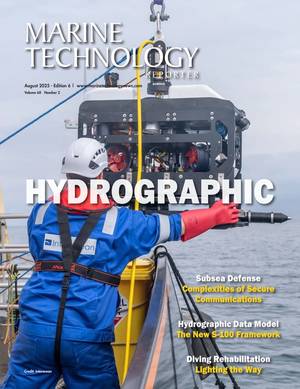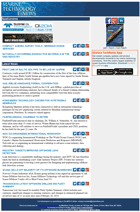
NOAA and Sofar Advance Weather Forecasting
NOAA’s Geophysical Fluid Dynamics Laboratory (GFDL) and Sofar Ocean have partnered to build modeling systems that advance marine weather forecasting.GFDL and Sofar’s three-year cooperation, which began in late 2024, combines parallel efforts at each organization to produce a coupled atmosphere-wave-ocean model that improves the accuracy of global marine weather forecasts and regional extreme weather scenarios.Scientists at NOAA and Sofar are already leveraging preliminary versions of the coupled model to produce more accurate ocean weather forecasts and improve safety at sea for coastal

USV Provides Near Real-Time Deep Ocean Current Observations
the Loop Current System.The project was completed during Fall 2025 and funded by the U.S. National Academies of Sciences, Engineering and Medicine’s Gulf Research Program. “Sustained deep-ocean measurements remain rare despite their importance,” says Randy Watts, Professor of Oceanography, URI. “This project demonstrates how commercially available instruments and uncrewed vehicles can deliver science-ready data in strong current systems – overcoming the dual challenges of station-keeping where most USVs fail and cost-effective deployment without expensive research vessels

Subsea Technology Helps Coral Larvae Find Home
This week, researchers at Australia’s Southern Cross University and CSIRO gave hope that millions of coral larvae on the Great Barrier Reef can help replenish degraded reefs thanks to the development of a “larval seedbox.”Results from the first trial have found coral settlement to be up to 56 times higher across thousands of square meters of reef. Large scale operation is achievable as tens of millions of larvae can be collected during the annual mass coral spawning that occurs each November in the Great Barrier Reef.The development comes as global warming is crossing dangerous

Larval Seedbox Boosts Coral Restoration
Millions of coral larvae on the Great Barrier Reef have an increased chance of replenishing degraded reefs thanks to the ‘larval seedbox’ - a coral restoration technology developed by CSIRO, Australia’s national science agency, with Southern Cross University.Results from the first trial of larval seedboxes have found coral settlement to be up to 56 times higher across thousands of square meters of reef.The trial was conducted at Lizard Island in 2024 and shows strong promise for use of seedboxes in scaling up coral restoration.Dr Christopher Doropoulos, Senior Research Scientist at

Deep-sea Mining Threatens “Twilight Zone” Ecosystem
;When the waste released by mining activity enters the ocean, it creates water as murky as the mud-filled Mississippi River. The pervasive particles dilute the nutritious, natural food particles usually consumed by tiny, drifting zooplankton,” said Michael Dowd, lead author of the study and oceanography graduate student in the UH Mānoa School of Ocean and Earth Science and Technology (SOEST).“Micronekton, small shrimp, fish and other animals that swim, feed on zooplankton. Some migrate between the depths and near surface waters and they are consumed by fish, seabirds and marine mammals

CCAMLR Talks End Without Consensus on Krill Fishing
After two weeks of negotiations in Hobart, the 44th annual meeting of the Commission for the Conservation of Antarctic Marine Living Resources (CCAMLR) has closed with little progress toward long-delayed goals to protect the Southern Ocean.Yet a growing group of members are standing strong for the protection of Antarctica, refusing to bow to pressure to expand industrial fishing in one of the planet’s most fragile ecosystems.“This year, conservation-minded countries showed that the future of Antarctica cannot be dictated by those who put fishing before protection,” said Claire
![Aerial view of the Rock Islands and coral seascape at the Republic of Palau. [Photo credit: The Nature Conservancy]](https://images.marinetechnologynews.com/images/maritime/w200h200padcanvas/aerial-view-rock-165050.jpg)
Bezos Funds AI Nature Projects
The Bezos Earth Fund has announced $30 million in new investments aimed at scaling AI to tackle biodiversity loss, climate change, and food insecurity.Each of 15 teams will receive up to $2 million as part of Phase II of the AI for Climate and Nature Grand Challenge.“AI can be a powerful ally to help make the world a better place,” said Lauren Sánchez Bezos, Vice Chair of the Bezos Earth Fund. “These innovators, using AI, are showing us new possibilities by reimagining how we grow food, protect wildlife, and power our planet to make a true impact.”The winning projects

Marine Heatwaves Impact Food Webs
New research shows that marine heatwaves can reshape ocean food webs, which in turn can slow the transport of carbon to the deep sea and hamper the ocean’s ability to buffer against climate change.The study, published in the scientific journal Nature Communications today, was conducted by an interdisciplinary team of researchers from MBARI, the University of Miami Rosenstiel School of Marine, Atmospheric, and Earth Science, the Hakai Institute, Xiamen University, the University of British Columbia, the University of Southern Denmark, and Fisheries and Oceans Canada.To explore the impacts of

Survey of Coral Sea Marine Park Begins
Scientists on board CSIRO research vessel Investigator are preparing to conduct a dedicated deep-sea survey of marine life in the Coral Sea Marine Park, off the coast of Queensland.This new research voyage will use RV Investigator’s extensive suite of scientific equipment including deep towed camera, eDNA sampler, trawls and sleds to explore biodiversity and better understand ecological changes.The research will be led by CSIRO, Australia’s national science agency, with support from Parks Australia, Bush Blitz and The Nippon Foundation-Nekton Ocean Census, and in collaboration with a

 August 2025
August 2025





